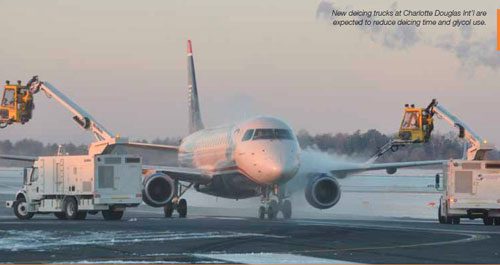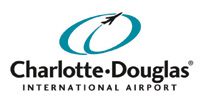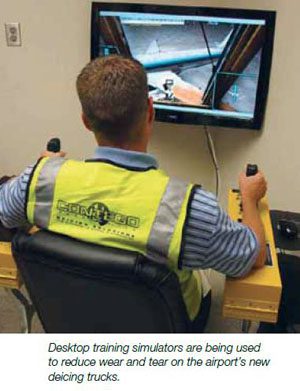
 In an effort to control glycol recovery and improve deicing times, Charlotte Douglas International Airport (CLT) took over US Airways’ deicing operations last winter and purchased 28 new deicing trucks.
In an effort to control glycol recovery and improve deicing times, Charlotte Douglas International Airport (CLT) took over US Airways’ deicing operations last winter and purchased 28 new deicing trucks.
Officials reasoned that the airport should assume responsibility for applying deicing fluid because it was
|
factsfigures Project: Deicing Operations Location: Charlotte Douglas Int’l Airport Budget: $10 million (28 trucks); $10 million (dispensing/collection system) Other Equipment: 4 training simulators Funding for Trucks: Passenger Facility Charges Funding for Dispensing/Collection System: Airport revenue bonds, with debt service paid for by PFCs Truck Manufacturer: Global Ground Support Deicing Management System: Aviata Systems Deicing Service Contract: Contego Systems LLC Timeline: Oct. 2010 – Jan. 2011 Noteworthy Details: Airport assumed control of US Airways’ deicing operations & contracted service to independent operator. |

The move also acknowledges a shift in philosophy. “It is obvious to us that the airlines are looking for ways to streamline their operations and focus on their core business, which is flying airplanes. We see it in all areas throughout the airport,” reports Orr.
CLT contracted Contego Systems LLC to provide aircraft deicing services and manage the staffing and training for deicing operations. The company also provided guidance about minimum requirements for the airport’s new fleet of deicing trucks.
New Operator, New Strategy
Contego’s arrival represents not only a changing of the guard at the airport, but a new approach to deicing operations as well. For example, CLT now uses desktop simulators for initial and recurrent training to reduce wear and tear – and possible damage – to its trucks.
The trucks themselves are different, too. Each requires only one operator vs. two for the former US Airways trucks. The new equipment (model 2200TEAPSO from Global Ground Support) also uses less glycol: Powerful forced air blowers remove loose snow from aircraft before heated glycol is applied. In frost conditions, glycol is injected in the airstream at a rate of three to four gallons per minute, compared to 40 gallons per minute from a conventional nozzle.
Based on Contego’s experience at other airports, company officials estimate the airport will likely reduce its glycol consumption up to 25% to 30%.
Contego equipped the trucks and pad manager tower with an IceGuard deicing management system from Aviata Systems. Touch-screen modules in the truck cabs allow operators and pad managers to communicate via text messages about deicing assignments and data collection (start/stop times of each step and amount of glycol used). A module installed on the pad controller’s computer provides access to departure schedules and aircraft data – information that facilitates the process of assigning aircraft to deicing pads and slots. Airline and Contego personnel can access real-time operations data, reports and key performance indicators down to individual trucks and operators via a central management module.
Before CLT’s new fleet arrived, Contego installed the IceGuard equipment in the existing US Airways trucks, which it leased from the airline until early 2011. Contego then re-installed the equipment in its new Global trucks.
During the changeover, US Airways provided truck maintenance while Contego operated the trucks and glycol fill station. Contego also underwent training about the airline’s winter deicing procedures and recruited, hired and trained approximately 180 part-time employees. “We had numerous meetings with US Airways to see what worked well for them and what areas they wanted to improve upon,” notes Bill Dempsey, a Contego director and temporary general manager of its CLT operation.
 Bring it On
Bring it On
CLT’s deicing operations typically run from November to March. The 2010-2011 season included 50 deicing days, 10 of which were snow events. Most deicing is for frost, but storms also often include freezing rain or sleet. Average snowfall at the airport is five to six inches per season.
Starting this season, deicing operations will be performed on three pads along Runway 5/23, which is closed when deicing services are required. Two aircraft will be able to queue up on each pad. Four trucks will deice each narrow- or wide-body aircraft at two of the pads. Two trucks will deice each regional jet on the third pad. Aircraft will then taxi to either 18C/36C or 18L/36R for takeoff. Contego will also deice aircraft on the cargo ramp using two trucks at each of four available positions.
|
New Life for Old Titans The opening of a new 9,000-foot runway in January 2010 required Charlotte Douglas International Airport to add two more Aircraft Rescue and Firefighting vehicles to its fleet. Choosing refurbished/remanufactured vehicles saved the airport about $1.2 million, according to estimates from the company that refurbished them. The airport purchased a 3,000-gallon 1991 E-ONE Titan, delivered in July 2010, and a 3,000-gallon 1993 E-ONE Titan, delivered late last year. Each vehicle cost about $350,000; both were purchased from Crash Truck Services at Company Two Fire. Before the vehicles were delivered, Crash Truck Services stripped the trucks to their frame rails, re-cored the radiators, and rebuilt the engines, brake systems and 1,800 gpm fire pumps and foam systems. To improve the equipment’s aesthetics, crews repainted the exteriors, refurbished the cab interiors, reupholstered the seats and installed new air conditioners. Crews also replaced the 600-gpm bumper turret and 1,200-gpm roof turret on the 1991 unit, rebuilt the 600-gpm turrets in the 1993 truck and installed new LED lights in both. Crash Truck Services tested the trucks per the FAA Advisory Circular Production Performance Evaluation that was in effect when they were manufactured and provided a one-year warranty on each refurbished/remanufactured unit. |
With seven major carriers, 14 regionals and two foreign flag airlines currently operating at CLT, Contego’s deicing crews could ultimately be much busier this winter.
If EPA implements new glycol recovery rules (despite condemnation about its Notice of Proposed Rulemaking) there will be a powerful incentive for airlines to switch to CLT’s services. Although there has never been glycol recovery at CLT, the airport is currently working on a system. “We originally planned to collect it in drains and pipe it into a storage tank,” says Orr. “We have a tertiary treatment plant, and are looking to make modifications to the system to recover and recycle the glycol.”
For more information about how other airports manage glycol recovery and treatment, see Page 30.


